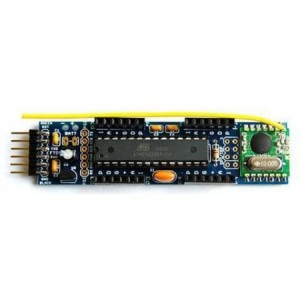Nifty Arduino/AVR hack: measuring VCC
 In my previous article pondering sensors for my garden, I shamefully neglected a viable and interesting choice, the JeeNode JeeNode is available here in the U.S. from Modern Device. It’s sold as a kit, which is unusual, but not particularly scary to assemble. It’s just a few through hole parts. It’s a pretty bare bones processor, but does interestingly include a wireless module. It uses the RFM12B modules running on either 433 or 915 Mhz. But what really makes the JeeNodes interesting to me are that they abandoned the (I submit) broken shield model of Arduino shields, and instead group the output pins for the Arduino into a collection of identical Ports which can be accessed using their JeeLib library. Each port consists of six pins (one ground, one Vcc, and four data pins) and all can be used to implement an I2C bus in software to access peripherals. Very cute, and much nicer than the hodge podge of existing code for the Arduinos.
In my previous article pondering sensors for my garden, I shamefully neglected a viable and interesting choice, the JeeNode JeeNode is available here in the U.S. from Modern Device. It’s sold as a kit, which is unusual, but not particularly scary to assemble. It’s just a few through hole parts. It’s a pretty bare bones processor, but does interestingly include a wireless module. It uses the RFM12B modules running on either 433 or 915 Mhz. But what really makes the JeeNodes interesting to me are that they abandoned the (I submit) broken shield model of Arduino shields, and instead group the output pins for the Arduino into a collection of identical Ports which can be accessed using their JeeLib library. Each port consists of six pins (one ground, one Vcc, and four data pins) and all can be used to implement an I2C bus in software to access peripherals. Very cute, and much nicer than the hodge podge of existing code for the Arduinos.
But the website at JeeLabs has a bunch of other cool stuff. Like details on one of their JeeNodes that’s been transmitting data wirelessly for over eight months, powered by just a coin cell. Or this Dive Into JeeNodes which is a tutorial on interfacing JeeNodes to a Raspberry Pi to make a house monitoring system. While the blog isn’t being updated anymore, it includes all sorts of good stuff, including this rather clever article on VCC Measurement (a software only way for an Arduino to determine it’s own input voltage). Great stuff.
I recall burning three or four weeks of a sabbatical getting Saccade.com on the air with Wordpress. So much tweaking…